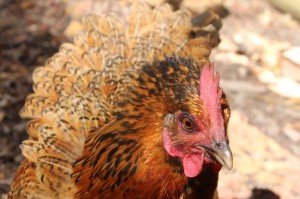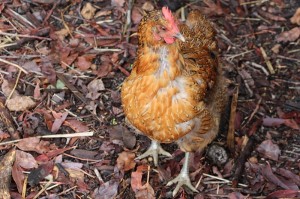Moulting Mama
 Mama Hen has the most beautiful feathers and colouring, she reminds me of a pheasant. She is not looking quite so attractive at the minute as she is in the middle of her annual moult.
Mama Hen has the most beautiful feathers and colouring, she reminds me of a pheasant. She is not looking quite so attractive at the minute as she is in the middle of her annual moult.
I have been collecting some her feathers as they are so striking. Chickens have between 1000 and 20,000 feathers depending on the breed, but I won’t be counting, or collecting them all. Chickens stop laying eggs when they are moulting so they can use the protein to grow new feathers and restock their bodies’ nutrients ready for another year of egg and shell production.
She could be off the lay for up to 3 months – some
low producing hens can stay in the moult for 6 months. Moulting takes place in a particular order. The feathers are lost first from the head and neck, then from the back, breast and abdomen, then the wings and finally from the tail. They even come off the wings in a specific order.
The new feathers emerge through a shaft with a blood supply, each protected by a waxy coating that falls off so the feather can unfurl, the blood supply then dries up. A good description with some images of new feathers growing are available on this HenCam blog.
Commercial breeders are more concerned about the loss of production and try various methods to manage the process including
forced moulting – where the birds are starved for 2 weeks to initiate a stress moult simultaneously in the whole flock. This has been outlawed in a number of countries including the UK where the Department for Environment, Food and Rural Affairs states: In no circumstances may birds be induced to moult by withholding feed and water.
Treating animals like machines to be turned off and on is not a humane thing to do, hopefully the consumer society will evolve to appreciate value, both of a chicken’s life and what it gives.

Facebook